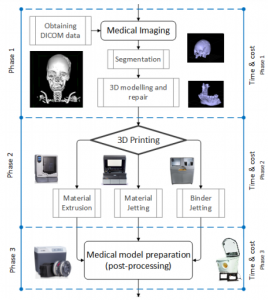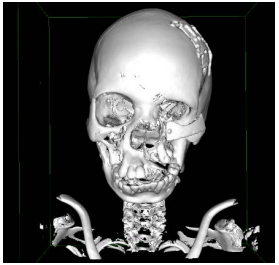 There are numerous applications for 3D printing in the medical industry, but one of the most prevalent is the 3D printing of medical models. It’s becoming easier and less expensive for medical professionals to 3D print models of patients’ anatomy so that they can plan and practice surgeries ahead of time, as well as educate patients and staff. A recent paper entitled “Workflow for 3D printing of medical models – phases, timeline and costs,” takes a close look at the process of 3D printing medical models, as well as the cost of doing so.
There are numerous applications for 3D printing in the medical industry, but one of the most prevalent is the 3D printing of medical models. It’s becoming easier and less expensive for medical professionals to 3D print models of patients’ anatomy so that they can plan and practice surgeries ahead of time, as well as educate patients and staff. A recent paper entitled “Workflow for 3D printing of medical models – phases, timeline and costs,” takes a close look at the process of 3D printing medical models, as well as the cost of doing so.
In the study, the researchers used CT images to 3D model and print a human skull and jawbone. They created several copies, using multiple methods of 3D printing including material extrusion, binder jetting and material jetting processes. The researchers describe in detail the processes they used to obtain the images for the models and to render them in 3D. The process is divided into three phases: imaging, 3D printing and medical model preparation or post-processing. Each phase has several subphases that add time and cost to the entire process.
First the DICOM data was obtained from an OsiriX DICOM sample image set, then imported to OsiriX MD 8.0.2 and segmented using 500 Hounsfield unit (HU) to add bone and more dense materials to the 3D model. The 3D file was exported in STL format to obtain the jaw and skull geometry.
“The STL file was first imported to DeskArtes 3D Data Export 10.3,” the researchers explain. “The shells were verified to separate volumes, which are not in contact with each other. The other shells except the jaw and skull were then removed. The models were repaired using automatic repairing tools. The jaw model was then ready and exported as a separate STL…file. The skull model required one more repairing round by first removing all error triangles and triangles next to the error triangles and further running an automatic repairing for a second time. The skull models were also exported as a separate STL file. After that both models were repaired and ready for the 3D-printing phase.”
For the material extrusion, also known as FDM or FFF 3D printing, the researchers used a Stratasys uPrint SE Plus, ABS Plus filament, and SR-30 Solubule Support Material. For material jetting, they used a Stratasys Objet30 Scholar 3D printer with Verowhite material and SUP705 support material. For binder jetting, they used a Zprinter 450 from 3D Systems, with ZP151 material.
 The fastest process was binder jetting, with a total processing time of two hours and 51 minutes for the jaw model and 10 hours and 24 minutes for the skull model. Material extrusion was faster than material jetting for the jaw model, but the opposite was true for the skull model. For the jaw model, material extrusion was the cheapest, with material jetting a close second. For the skull model, binder jetting was the cheapest, closely followed by material extrusion. Material jetting is the most geometrically accurate process, but binder jetting is the easiest to print in different colors.
The fastest process was binder jetting, with a total processing time of two hours and 51 minutes for the jaw model and 10 hours and 24 minutes for the skull model. Material extrusion was faster than material jetting for the jaw model, but the opposite was true for the skull model. For the jaw model, material extrusion was the cheapest, with material jetting a close second. For the skull model, binder jetting was the cheapest, closely followed by material extrusion. Material jetting is the most geometrically accurate process, but binder jetting is the easiest to print in different colors.
“Costs of 3D printing will be reduced in the future as the technology and the used materials will be further developed,” the researchers conclude. “More importantly, this will subsequently create new applications areas. Even quite high costs for 3D-printed medical models can be acceptable if their use will save time in operation and lead to better operation outcomes.”
Authors of the paper include Mika Salmi, Inigo Flores Ituarte, Jukka Tuomi, and Antti Mäkitie.
Discuss this and other 3D printing topics at 3DPrintBoard.com or share your thoughts below.
Subscribe to Our Email Newsletter
Stay up-to-date on all the latest news from the 3D printing industry and receive information and offers from third party vendors.
Print Services
Upload your 3D Models and get them printed quickly and efficiently.
You May Also Like
Havaianas Collaborates with Zellerfeld to Launch 3D Printed Flip-Flops
The shoe of the summer is undoubtedly the flip-flop. Easy on, easy off, your feet won’t get sweaty because there’s not much material, and they’re available in a veritable rainbow...
UCLA Researchers Develop 3D Printed Pen that May Help Detect Parkinson’s Disease
Diagnosing Parkinson’s disease is difficult. Often, early symptoms of the progressive neurological condition may be overlooked, or mistaken for signs of aging. Early diagnosis can help save lives and improve...
Printing Money Episode 30: Q1 2025 Public 3D Printing Earnings Review with Troy Jensen, Cantor Fitzgerald
Printing Money is back with Episode 30, and it’s that quarterly time, so we are happy and thankful to welcome back Troy Jensen (Managing Director, Cantor Fitzgerald) to review the...
Heating Up: 3D Systems’ Scott Green Discusses 3D Printing’s Potential in the Data Center Industry
The relentless rise of NVIDIA, the steadily increasing pledges of major private and public investments in national infrastructure projects around the world, and the general cultural obsession with AI have...

































